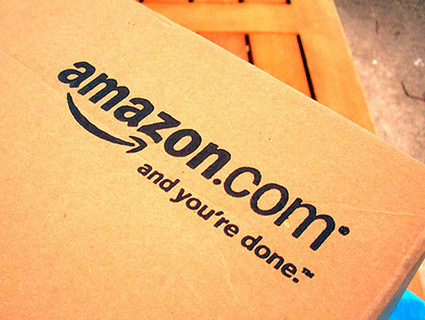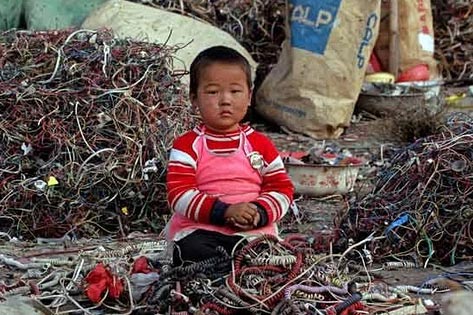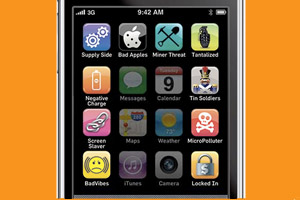UPDATE: This American Life has retracted the story it ran about monologist Mike Daisey’s visit to Chinese factories; Daisey has admitted that he fabricated significant portions of the story. The piece “uses a combination of fact, memoir, and dramatic license to tell its story,” he wrote in a blog post. “What I do is not journalism.”
—
Almost everyone I know owns something made by Apple, and while most of us spend a fair bit of time obsessing about our gadgets—which apps are worth paying for? Is Siri useful or annoying?—rarely do we talk about where they came from. In part, that’s because Apple wants it that way: The company is famously tight-lipped about its manufacturing process, and few outsiders have ever made it into their factories.
But now, Apple’s tough facade has finally begun to crack: Recent coverage (more on this below) has provided a glimpse into Apple’s vast supply chain and the massive profits it produces—more than $400,000 for every employee, according to a New York Times investigation. Here at Mother Jones, we’ve got a somewhat related investigation in the pipeline—come back in a few weeks for the details. Meanwhile, my colleague Dave Gilson made this handy tool.
We’ve loaded this iPhone up with 10 apps you won’t find on a real smart phone. Click on an app to learn where your phone’s electronic components really came from.
 |
||||||||
 |
 |
 |
 |
|||||
 |
 |
 |
||||||
 |
 |
|||||||
 |
 |
|||||||
 |
 |
|||||||
 |
||||||||
Supply Side
Apple spends an estimated $100 on the iPhone’s 1,000-plus parts. It keeps a tight lid on where in the world they come from. If you deconstruct the gadget, you’ll find fewer than 130 parts with a brand name or “made in” label on them.
Bad Apples
iPhones are made in Shenzhen, China, by the Taiwanese company Foxconn, which has been criticized for its working conditions, including long hours, harsh discipline, and a rash of worker suicides. Apple’s own reviews found that more than half its audited manufacturers did not meet its labor standards for things such as child labor.
Miner Threat
A 16GB iPhone 3GS contains 12 gold-plated parts. Producing 1 ounce of gold creates 80 tons of waste. Layers of middlemen make it difficult to trace the source of the gold (or any other metal) in an iPhone, making it easy for minerals from conflict zones to slip into the supply chain.
Tantalized
The iPhone includes a tantalum capacitor. After a United Nations report linked its manufacturer, Kemet, to the illegal mineral trade in eastern Congo, the company vaguely announced it “supports avoiding” tantalum from the region.
Negative Charge
Rechargeable batteries have energized demand for lithium. Getting more will mean digging up 3,000 square miles of pristine Bolivian salt flats, home to one-half of the world’s lithium reserves.
Tin Soldiers
Tin is used to solder circuit boards. Some 27,000 tons are extracted from Congo annually, earning armed groups an estimated $93 million or more.
Screen Slaver
The 3.5-inch LCD screen is reportedly made in Taiwan and China by Wintek, which has faced allegations of low wages, forced overtime, and ripping off migrant workers.
BadVibes
High-density tungsten is used to make cell phones vibrate. Three-quarters of the world’s supply comes from China—not known for its mining safety record—and 1,400 tons are dug up annually in Congo.
MicroPolluter
Making a 0.07-ounce microchip uses 66 pounds of materials, including water and toxic chemicals such as flame retardants and chlorinated solvents. Greenpeace gives Apple a 4.6 out of 10 for its efforts to eliminate hazardous chemicals and minimize e-waste.
Locked In
The list price for a 16GB iPhone 4S is $649. It’s yours for less than $200, if you don’t mind being locked into a two-year contract with AT&T or Verizon.
This week, the New York Times has launched a series called “The iEconomy,” and the first piece in the series focused on Apple’s massive outsourcing of jobs to China. No task is too big, no deadline too tight:
One former executive described how the company relied upon a Chinese factory to revamp iPhone manufacturing just weeks before the device was due on shelves. Apple had redesigned the iPhone’s screen at the last minute, forcing an assembly line overhaul. New screens began arriving at the plant near midnight.
A foreman immediately roused 8,000 workers inside the company’s dormitories, according to the executive. Each employee was given a biscuit and a cup of tea, guided to a workstation and within half an hour started a 12-hour shift fitting glass screens into beveled frames. Within 96 hours, the plant was producing over 10,000 iPhones a day.
Another article focused on the “harsh conditions” at the Chinese factories where Apple gadgets are made.
A few weeks back, there was an incredible episode of This American Life, wherein Mike Daisey, a monologist and “self-described worshipper in the cult of Mac” visits the Foxconn factory in Shenzhen, China, where iPads are made. What he finds there is mind-boggling. First, the sheer size of the place: 34,000 workers. The cafeterias seat thousands, and the dormitories are so crowded the beds remind Daisey of coffins.
Daisey meets a young woman who cleans iPad screens and discovers that she is just 13. While he is there, a worker dies after a 34-hour shift. But the most chilling part was Daisey’s description of the factories as virtually silent. There’s no thrum of machinery, he realizes, because there are hardly any machines. What we miss when we wax nostalgic about a time when things were made by hand, he says, is that “There are more handmade things now than there have ever been.”
More bad news: Back in August, the Chinese NGO Institute of Public & Environmental Affairs released a report (PDF) on the pollution created by Apple’s sprawling supply chain. Among its findings was that Apple doesn’t even seem to be looking for environmental problems during its factory audits:
…the coalition has discovered more than 27 suspected suppliers to Apple that have had environmental problems. However, in the ‘2011 Supplier Responsibility Report’ published by Apple Inc., where core violations were discovered from the 36 audits, not a single violation was based on environmental pollution…Therefore, despite Apple’s seemingly rigorous audits, pollution is still expanding and spreading along with the supply chain.
Of course, none of this is good news for gadget hounds. But is it bad enough to make people swear off iPads? Or at least to pressure Apple to change its ways?
















